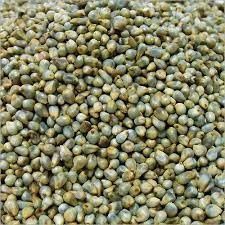
Pearl Millet
Types of Millets: There are several types of millets, including pearl millet (bajra), finger millet (ragi), foxtail millet, proso millet, and barnyard millet. Each type has its own unique nutritional composition and culinary uses. Nutritional Benefits: Millets are packed with essential nutrients such as fiber, protein, vitamins (B-complex, especially niacin and thiamine), minerals (iron, calcium, phosphorus), and antioxidants. Health Benefits: Regular consumption of millets has been associated with numerous health benefits. They can help manage weight, improve digestion, lower cholesterol levels, reduce the risk of heart disease, and control blood sugar levels. Millets are also known to have anti-inflammatory properties. Culinary Uses: Millets can be used in various culinary preparations. They are commonly used to make porridge, flatbreads, pilafs, and even fermented products like idli and dosa. The grains can be cooked whole, ground into flour, or used as flakes. Environmental Sustainability: Millets are considered environmentally friendly crops due to their low water requirements and ability to grow in poor soil conditions. They are resilient to drought and require fewer pesticides and fertilizers compared to other cereal grains. Food Security: Millets play a crucial role in ensuring food security, particularly in developing countries. They are often grown by small-scale farmers and provide a reliable source of nutrition and income, especially in regions prone to climatic uncertainties. Global Significance: Millets are not only consumed in specific regions but are gaining popularity worldwide due to their nutritional value and sustainable characteristics. They have been recognized by the United Nations as important crops for addressing global food security and climate change challenges. In conclusion, millets are ancient grains that offer a range of nutritional benefits, have versatile culinary uses, and contribute to sustainable agriculture.
...moreBe first to Rate
Rate ThisOpening Hours